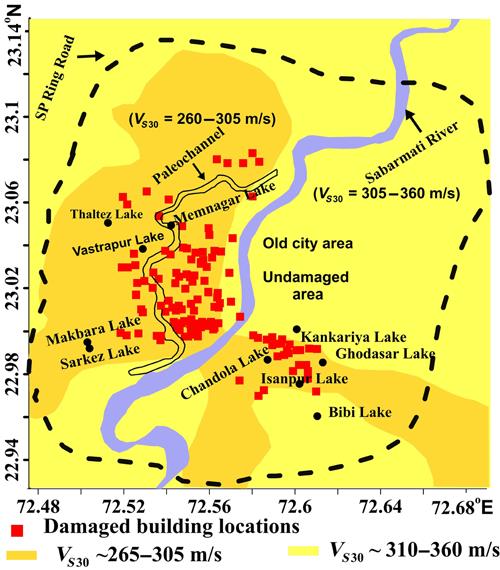Detailed geophysical and geological investigations to identify copper lead and zinc mineralization around Ambaji, Banaskantha district are in progress.

 Skip To Main Content
Skip To Main Content
The city of Ahmedabad of Gujarat in western India suffered severe damage during the 2001 Mw 7.7 Bhuj earthquake, despite being ∼250 km away from the epicenter. Similar damage patterns were also reported during the 1819 Allah Bund earthquake (Mw 7.8). To investigate the probable causes, we employed an integrated approach using multichannel analysis of surface waves (MASW), single and array microtremor measurements, broadband earthquake data, and geotechnical investigations. Significant differences in site characteristics are observed in both the damaged and undamaged areas. The investigations revealed shear-wave velocity values in excess of 320 m/s and less than 220 m/s in the undamaged and damaged areas, respectively, in the top 6 m of the subsurface. The refusal (N1(60)) values are observed at 6–20 m and 20 m depth onward in the undamaged and damaged areas, respectively. The amplification factor in the damaged areas varies from 3.3 to 6.6 in the 1.5–2.0 Hz frequency range. On the other hand, the amplification factor in the undamaged areas varies from 1.0 to 3.0 in the 0.7–1.5 Hz frequency range. Nevertheless, the damages were mostly restricted to mid-to-high-rise buildings, located in the western side of the Sabarmati River, where the presence of a paleochannel is reported, and in some southeastern parts of the city, along lakes and ponds. The low-rise buildings on the eastern side of the river in the old city area remained almost intact. Our study confirms that local site effects together with the poor quality of construction contributed to the damages.

Map showing the VS30 variation in Ahmedabad area
Sairam, B., Singh A.P., Patel, V., Pancholi, V., Chopra S., Dwivedi V.K. and Kumar M. R. (2018) Influence of Local Site Effects in the Ahmedabad Mega City on the Damage due to Past Earthquakes in Northwestern India, Bulletin of the Seismological Society of America, 108(4), 2170–2182.
Copyright © 2017 - All Rights Reserved by - Official Website of Institute of Seismological Research, Government Of Gujarat, India.
Note: Content on this website is published and managed by Institute of Seismological Research.
For any query regarding this website, please contact the web information manager Mr. Jignesh Patel (Technical Officer) : email id-dg-isr[at]gujarat[dot]gov[dot]in
